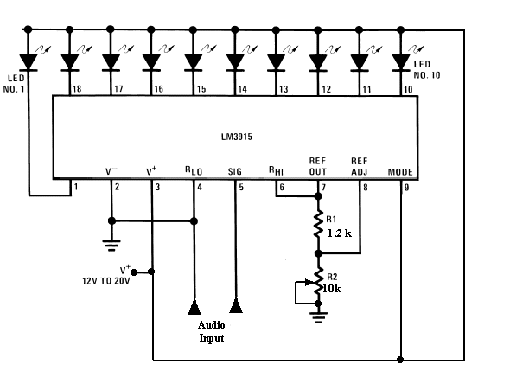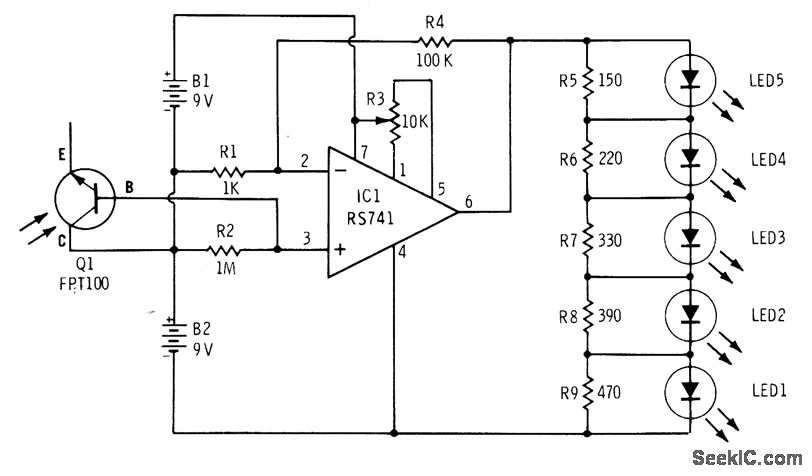
lm 3915 vu meter

This meter appears to function well, as demonstrated in a YouTube video about the LM3915 circuit. However, the schematic differs significantly. If the provided schematic is followed, it is uncertain whether everything would operate correctly. A peak detector circuit at the input is recommended to ensure that momentary peak voltages illuminate the LEDs sufficiently to appear bright, rather than dim or unnoticeable. A custom circuit was created using the LM3915, incorporating a 68-ohm 1/2 watt resistor between the anode of the LEDs and the positive power source. The original 2.7k resistor was replaced with a 1.2k resistor. For demonstration purposes, 3mm LEDs were used due to PCB size constraints, and the circuit operates on a +9V battery with an on/off switch included. The passive peak detector circuit using a diode fails to register low signal levels below 0.6V peak, resulting in inadequate display of low signals. Despite this limitation, the circuit has been effective within the constraints of minimal components and space. Currently, the circuit is connected to the "lineout" of a sound card, with maximum sound settings in the operating system to ensure sufficient signal strength. A 10k potentiometer allows for sensitivity adjustment to prevent excessive LED illumination, which could lead to quicker battery drainage. Amplified stereo speakers with volume control are used, making the preamplified output preferable, as the VU meter remains functional regardless of speaker volume. The circuit may have been designed for direct connection to speakers, where higher peak power can overcome the 0.6V drop of the diodes. It has been noted that the transistor-based peak detector circuit can cause overheating of the chip and excessive LED activation if not configured correctly. The transistor and diode must be connected properly; otherwise, incorrect diode selection, such as a 1N400x rectifier, may result in unintended LED activation without an input signal. It is also mentioned that a 1N4148 diode functions similarly to a 1N914 diode.
The described circuit is a visual audio level indicator utilizing the LM3915 LED display driver, which can be configured for various applications, including audio signal monitoring. The LM3915 operates by lighting up a series of LEDs proportionally to the input voltage level, providing a visual representation of the signal strength. The addition of a peak detector circuit is essential for accurately capturing transient peaks in audio signals, ensuring that the LEDs illuminate brightly enough to be noticed during brief signal spikes.
In this implementation, the choice of components plays a crucial role in performance. The 68-ohm resistor serves to limit the current flowing through the LEDs, protecting them from excessive current that could lead to failure. The substitution of the 2.7k resistor with a 1.2k resistor alters the sensitivity of the circuit, allowing for a more responsive display that better reflects audio signal dynamics.
The passive peak detector's limitation in detecting low signal levels below 0.6V is a significant consideration for audio applications where low-level signals are common. A more effective solution may involve an active peak detection circuit, which could provide better performance across a wider range of input signal amplitudes.
The use of a 10k potentiometer allows for fine-tuning of the circuit's sensitivity, which is particularly beneficial in environments with varying signal strengths. This feature helps to prevent the LEDs from constantly peaking, which can lead to unnecessary power consumption and reduce battery life.
In summary, this schematic provides a basic yet functional design for an audio VU meter, leveraging the LM3915 and a peak detector circuit. Careful component selection and configuration are essential for optimal performance, particularly in maintaining the integrity of low-level signals while ensuring the circuit remains compact and efficient.* This meter looked like it works well: YouTube - IndikG tor vybuzenG s LM3915 but the schematic is quite different. Google Translate If I followed that schematic, do you think everything would still work You should use a peak detector circuit at the input so that momentary peak voltages light the LEDs long enough to appear bright, instead of th
e dim blur or not seen. I made one myself not too long ago using the LM3915, not my schematic, but i use it and not pictured, i added a 68 © 1/2w resistor between the anode end of the LEDs and the positive power source. I also substituted the shown 2. 7k resistor for a 1. 2k resistor. For demo purposes due to the size limitation of the PCB, i used 3mm LEDs, hooked up for single channel, runs off a +9v battery and i incorporated an off/on switch.
The passive peak detector using a diode ruins the low signal levels that have a voltage less than 0. 6V peak so the circuit does not show the low signal levels. The passive peak detector using a diode ruins the low signal levels that have a voltage less than 0. 6V peak so the circuit does not show the low signal levels Unfortunately true. but i wanted to use as little parts/space as possible due to the size of the PCB i used and it works well for me. For the moment, my circuit is hooked up to the "lineout" of the sound card and to get more than enough signal strength, i max the sound in windows.
With the 10k pot, i can always adjust the sensitivity to the IC so the LEDs are not peaking half the time causing a quicker battery drain. I use amplified stereo speakers that has volume control so it doesnt matter and i prefer using the preamped output because the vu meter still displays no matter what volume level on the speakers.
I may be wrong but im sure this circuit was more designed towards hooking up directly to speakers wheres theres more peak power to overcome the 0. 6v drop of the diodes. Yeah. the peak detector circuit doesn`t work. The one with the transistor, not the other one. Just causes the chip to get super hot and light up most of the LEDs. I could`ve set it up wrong, but I triple checked. The transistor peak detector circuit works perfectly if the transistor and diode are not connected backwards.
If the wrong diode is used (a 1N400x rectifier) then a few LEDs might light without an input signal. A 1N4148 diode is the same as a 1N914 diode. 🔗 External reference
The described circuit is a visual audio level indicator utilizing the LM3915 LED display driver, which can be configured for various applications, including audio signal monitoring. The LM3915 operates by lighting up a series of LEDs proportionally to the input voltage level, providing a visual representation of the signal strength. The addition of a peak detector circuit is essential for accurately capturing transient peaks in audio signals, ensuring that the LEDs illuminate brightly enough to be noticed during brief signal spikes.
In this implementation, the choice of components plays a crucial role in performance. The 68-ohm resistor serves to limit the current flowing through the LEDs, protecting them from excessive current that could lead to failure. The substitution of the 2.7k resistor with a 1.2k resistor alters the sensitivity of the circuit, allowing for a more responsive display that better reflects audio signal dynamics.
The passive peak detector's limitation in detecting low signal levels below 0.6V is a significant consideration for audio applications where low-level signals are common. A more effective solution may involve an active peak detection circuit, which could provide better performance across a wider range of input signal amplitudes.
The use of a 10k potentiometer allows for fine-tuning of the circuit's sensitivity, which is particularly beneficial in environments with varying signal strengths. This feature helps to prevent the LEDs from constantly peaking, which can lead to unnecessary power consumption and reduce battery life.
In summary, this schematic provides a basic yet functional design for an audio VU meter, leveraging the LM3915 and a peak detector circuit. Careful component selection and configuration are essential for optimal performance, particularly in maintaining the integrity of low-level signals while ensuring the circuit remains compact and efficient.* This meter looked like it works well: YouTube - IndikG tor vybuzenG s LM3915 but the schematic is quite different. Google Translate If I followed that schematic, do you think everything would still work You should use a peak detector circuit at the input so that momentary peak voltages light the LEDs long enough to appear bright, instead of th
e dim blur or not seen. I made one myself not too long ago using the LM3915, not my schematic, but i use it and not pictured, i added a 68 © 1/2w resistor between the anode end of the LEDs and the positive power source. I also substituted the shown 2. 7k resistor for a 1. 2k resistor. For demo purposes due to the size limitation of the PCB, i used 3mm LEDs, hooked up for single channel, runs off a +9v battery and i incorporated an off/on switch.
The passive peak detector using a diode ruins the low signal levels that have a voltage less than 0. 6V peak so the circuit does not show the low signal levels. The passive peak detector using a diode ruins the low signal levels that have a voltage less than 0. 6V peak so the circuit does not show the low signal levels Unfortunately true. but i wanted to use as little parts/space as possible due to the size of the PCB i used and it works well for me. For the moment, my circuit is hooked up to the "lineout" of the sound card and to get more than enough signal strength, i max the sound in windows.
With the 10k pot, i can always adjust the sensitivity to the IC so the LEDs are not peaking half the time causing a quicker battery drain. I use amplified stereo speakers that has volume control so it doesnt matter and i prefer using the preamped output because the vu meter still displays no matter what volume level on the speakers.
I may be wrong but im sure this circuit was more designed towards hooking up directly to speakers wheres theres more peak power to overcome the 0. 6v drop of the diodes. Yeah. the peak detector circuit doesn`t work. The one with the transistor, not the other one. Just causes the chip to get super hot and light up most of the LEDs. I could`ve set it up wrong, but I triple checked. The transistor peak detector circuit works perfectly if the transistor and diode are not connected backwards.
If the wrong diode is used (a 1N400x rectifier) then a few LEDs might light without an input signal. A 1N4148 diode is the same as a 1N914 diode. 🔗 External reference





